Search Knowledge Base by Keyword
RSI Divergence and Trading RSI
Introduction
One of the most widely utilized momentum indicators in cryptocurrency trading is the Relative Strength Index (RSI). This article describes how to calculate RSI, how to read RSI divergence, and how traders may use RSI signals, such as failure swings, breakout confirmations, overbought/oversold levels, and divergences, to enhance their cryptocurrency trading tactics.
Crypto RSI explained: Relative Strength Index (RSI) is in crypto a momentum indicator that measures the magnitude of recent price changes to analyze overbought or oversold conditions.
RSI values range from 0 to 100.
How to calculate RSI Indicator and RSI Divergence?
The relative strength index (RSI) is calculated using the following formula: RSI = 100 – 100 / (1 + RS) Where RS = Average gain of up periods during the specified time frame / Average loss of down periods during the specified time frame asset price is considered overbought (due for a correction) when RSI is above 70, and oversold (due for a rebound) when it is below 30. Some traders use more extreme levels (80/20) to reduce false readings.
In a strong uptrend, RSI will often reach 70 and beyond for sustained periods, and downtrends can stay at 30 or below for a long time. While general overbought and oversold levels can be accurate, they may not provide the most timely signals for trend traders.
Explore Free Trading Tips!
RSI Divergence Crypto Trading Strategy Example
Trend traders can use RSI in their trading strategy to buy near oversold conditions when the trend is up (i.e. buy the dips – see chart 1 below), and sell short near overbought condition in a downtrend (i.e. sell the rebound). Let’s assume that the long-term trend of an asset is up. A buy signal occurs when the RSI moves below 50 and then back above it. Essentially, this means a pullback in price has occurred, and the trader is buying once the pullback appears to have ended (according to the RSI) and the trend is resuming. The 50 level is used because the RSI doesn’t typically reach 30 in an uptrend unless a potential reversal is underway. A short-trade signal occurs when the trend is down and the RSI moves above 50 and then back below it.
The RSI is often used in conjunction with trendlines, as trendline support or resistance often coincides with support or resistance levels in the RSI reading.
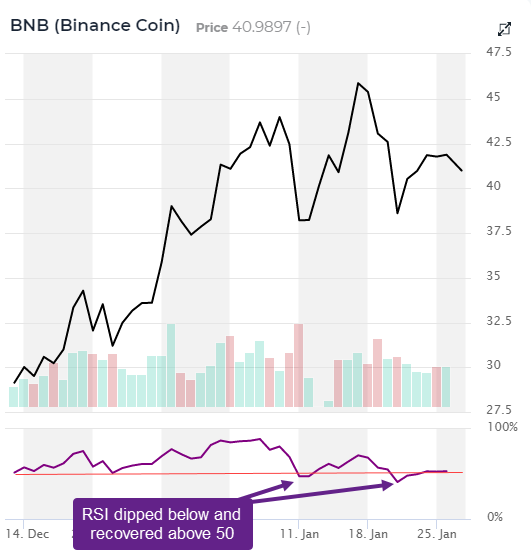
Watching for RSI divergence between price and the RSI indicator is another way to use it in your crypto trading strategy.
Divergence occurs when a cryptocurrency price makes a new high or low in price but the RSI does not make a corresponding new high or low value. A bearish divergence forms when a coin price records a higher high and RSI forms a lower high (see chart 2 above). RSI does not confirm the new high and this shows weakening momentum. Bullish divergence, which is interpreted as a buy signal, occurs when price makes a new low, but the RSI value does not.
RSI divergence signals tend to be more accurate on the longer time frames (min 1-hour charts). You get fewer false signals

Benefits and Drawbacks of RSI Divergence
RSI divergence is a strong indication, although it is not always accurate. Divergences can occasionally show up too soon, and prices may keep rising before turning around. For this reason, a lot of traders mix RSI divergence with other indicators including candlestick patterns, support/resistance levels, and chart patterns (such falling wedges). Traders can boost the likelihood of successful entrances and exits by combining numerous signals.
Reading RSI Divergence Indicator Can Also Be Used As a Confirmation of a Breakout!
Here’s an example of how Bullish RSI Divergence preceded a bullish breakout from Falling Wedge pattern. Together, these two signals create a strong case:

Failure swings can also be strong indications of an upcoming reversal. Failure swings are independent of price action. In other words, failure swings focus solely on RSI for crypto signals and ignore the concept of divergences. A bullish failure swing forms when RSI moves below 30 (oversold), bounces above 30, pulls back, holds above 30 and then breaks its prior high. It is basically a move to oversold levels and then a higher low above oversold levels.
A bearish failure swing forms when RSI moves above 70, pulls back, bounces, fails to exceed 70 and then breaks its prior low. It is basically a move to overbought levels and then a lower high below overbought levels.
What other Candlestick Patterns or Indicators could be used to Strengthen the RSI Divergence Signal?
Combining RSI divergence with other confirmation signals is a smart way to reduce false entries and increase confidence. Here’s a short list of top candlestick patterns and indicators that work well with RSI divergence:
✅ Top Candlestick Patterns for Confirmation
Pattern Signal Type Why It Helps:
- Bullish Engulfing Bullish Strong reversal after a downtrend — confirms bullish divergence.
- Bearish Engulfing Bearish Strong reversal after an uptrend — confirms bearish divergence.
- Hammer / Inverted Hammer Bullish Shows buyer rejection at lows — good near bullish divergence.
- Shooting Star / Hanging Man Bearish Shows seller rejection at highs — useful for bearish divergence.
- Doji Indecision Can mark a turning point, especially with volume shift.
📊 Indicators That Strengthen Divergence Signals
Indicator Usage How It Helps:
- MACD Trend/momentum Confirm divergence if MACD shows cross or histogram shift.
- Volume Strength of move Look for volume increase during divergence resolution.
- Moving Averages (e.g. 50/200 EMA) Trend filter Only trade divergence in direction of major trend.
- Stochastic RSI Extra momentum filter If both RSI divergence & Stoch RSI show reversal → strong.
- Bollinger Bands Overextension Divergence near band extremes adds conviction.
- Support/Resistance Zones Context Divergence near key levels = more likely reversal.
- Chart Patterns (e.g. wedge, triangle) Structure Breakout + divergence = powerful combo (e.g., falling wedge + bullish divergence).
🔁 Example Combo (Real Use):
Bullish Setup:
- Price makes lower low
- RSI makes higher low (bullish divergence)
- At horizontal support level
- Hammer candle appears
- Volume increases on breakout
✅ = High-confidence entry
How To Find RSI Divergence and Trading RSI on altFINS
Crypto traders on altFINS can easily filter over 3,000 cryptocurrencies to find RSI oversold or overbought situations by checking our Signal Summary page or Pre-set filters on altFINS Crypto Screener. Alternatively, traders can also build their own custom filter using altFINS Screener. Or select bullish or bearish RSI Divergence in Trade Setups. See how to use our Screener here.
You can also ask altFINS AI Copilot
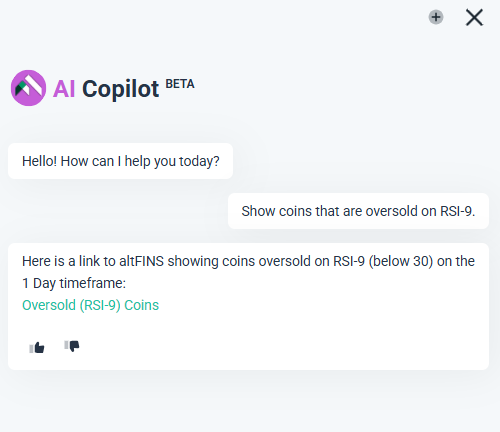
Ask AI Copilot to have fresh data
Quickly Scan For RSI RSI Divergence and Trading RSI on altFINS Crypto Screener
Bullish RSI Divergence in Pre-set Filters`

Trading RSI in Pre-set Filters
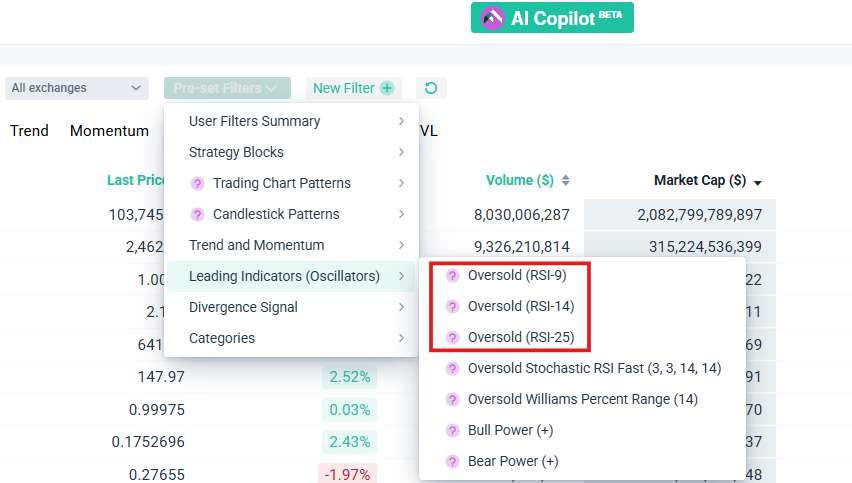
Create a Custom filter on Crypto Screener
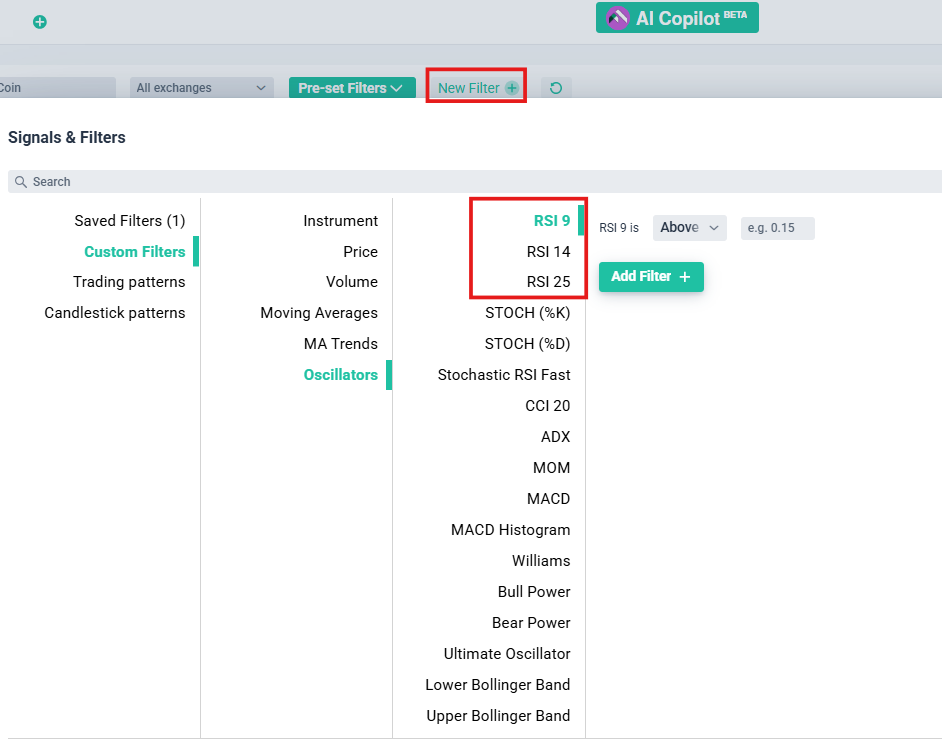
Go to Signals Summary and Find Bullish and Bearish Coins with RSI Divergence or Trading RSI
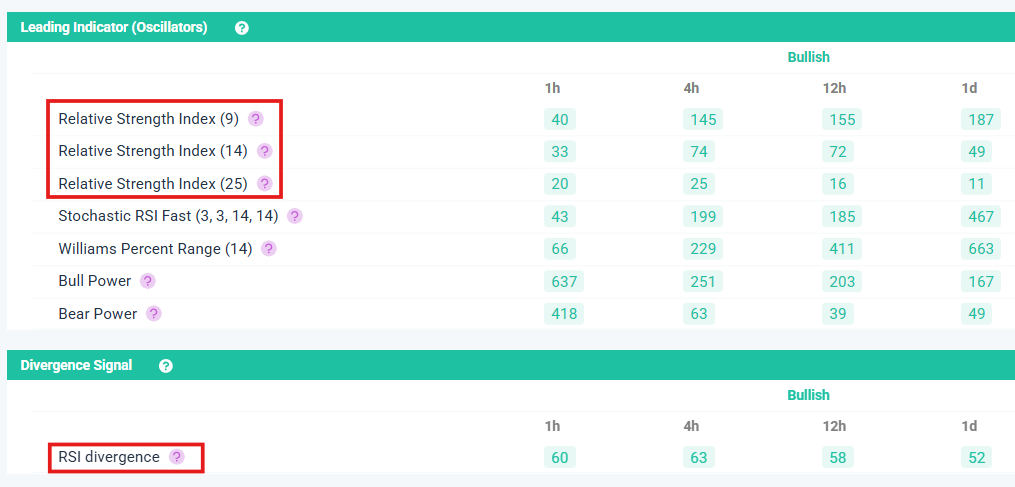
And after running the Pre-set Filter, you can add the RSI Divergence indicators to the Screener.

Aldo add RSI Divergence to the charts. Open Detail View for a selected coin. Add RSI (14-period). Draw trendlines on price and RSI to confirm divergence visually.
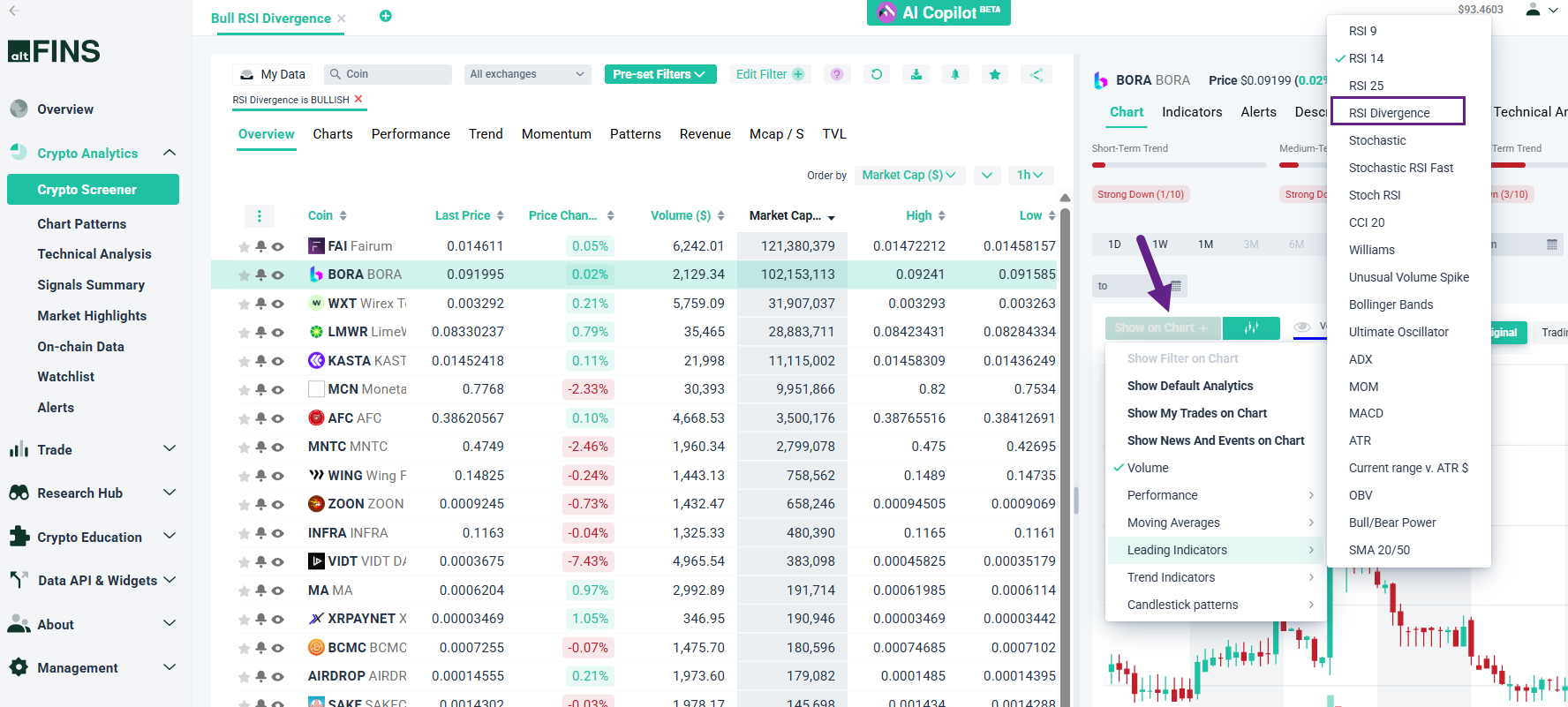
Select RSI Divergence on Trade Setups Section
Identify Divergence Patterns:
🔹 Bullish Divergence: Price makes a lower low, RSI makes a higher low.
🔹 Bearish Divergence: Price makes a higher high, RSI makes a lower high.
Summary
1. Use altFINS tools to find divergence.
2. Confirm visually on the chart.
3. Combine with other technical signals.
4. Apply strong risk management.
